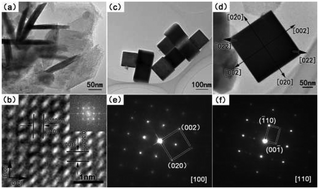Synthesis of variously shaped magnetic FeCo nanoparticles and the growth mechanism of FeCo nanocubes†
Abstract
By varying the molar ratio of Fe2+/Co2+ and the concentration of PEG-400 and cyclohexane, as well as the reaction temperature and time, FeCo alloy nanoparticles with different morphologies have been synthesized successfully, in which the iron content could be adjusted in the range of 17–84 at%. Accompanying the decrease of the Fe2+/Co2+ molar ratio from 5 : 1 to 1 : 5, the shapes of FeCo nanoparticles change from sheets, cubes and spheres to flower-like particles, which were confirmed by X-ray powder diffraction, scanning electron microscopy and transmission electron microscopy. Typically, the growth direction of nanosheets is along the [110] direction exposing (110) surface planes, while FeCo nanocubes have a perfect square shape with clear-cut edges and expose {100} surface facets. It is found that the combined action of PEG-400 and cyclohexane plays a vital role in regulating the growth rate of different crystal facets. Under the assistance of PEG-400 and cyclohexane, the growth of perfect cubes with some intermediates can be observed. Their addition effects were discussed, and a “step-by-step surface wrapping” growth mechanism was proposed to illustrate the formation of nanocubes. Among different nanoparticles, Fe75Co25 nanocubes (250 ± 10 nm) have the highest saturation magnetization, which is measured to be 250 emu g−1.



 Please wait while we load your content...
Please wait while we load your content...